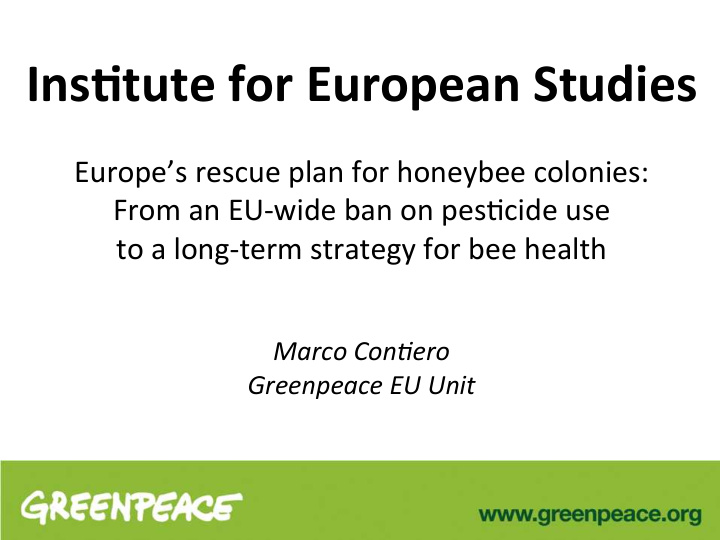



Ins$tute ¡for ¡European ¡Studies ¡ ¡ ¡ Europe’s ¡rescue ¡plan ¡for ¡honeybee ¡colonies: ¡ ¡ From ¡an ¡EU-‑wide ¡ban ¡on ¡pes:cide ¡use ¡ ¡ to ¡a ¡long-‑term ¡strategy ¡for ¡bee ¡health ¡ ¡ ¡ Marco ¡Con)ero ¡ ¡ Greenpeace ¡EU ¡Unit ¡ ¡
• What ¡are ¡the ¡ next ¡steps ¡ of ¡ac:on? ¡ • Will ¡the ¡two-‑year ¡ban ¡lead ¡to ¡a ¡comprehensive ¡ long-‑term ¡ strategy ¡ to ¡tackle ¡the ¡decline ¡of ¡Europe’s ¡honeybee ¡ popula:on? ¡ • What ¡future ¡ measures ¡should ¡be ¡incorporated ¡in ¡this ¡ strategy? ¡ ¡ • Will ¡ other ¡countries , ¡in ¡par:cular ¡the ¡US, ¡ follow ¡EU’s ¡ban ¡ on ¡bee-‑harming ¡pes:cides? ¡
The ¡Value ¡of ¡bees ¡and ¡pollinators ¡ 1/3 ¡ of ¡crops ¡we ¡eat ¡are ¡pollinated ¡by ¡insects ¡ ¡ €265bn ¡ is ¡the ¡global ¡economic ¡benefit ¡of ¡pollina:on ¡ ¡ 71 ¡of ¡the ¡100 ¡crop ¡species ¡providing ¡90% ¡of ¡food ¡worldwide ¡are ¡bee-‑ pollinated ¡(FAO) ¡ ¡ 4.000 ¡ European ¡vegetable ¡varie:es ¡are ¡bee-‑pollinated ¡(FAO) ¡
Causes of bees decline “No ¡single ¡factor ¡can ¡be ¡blamed ¡for ¡the ¡overall ¡global ¡bees ¡decline” ¡ ¡ “Decline ¡is ¡product ¡of ¡mul:ple ¡factors ¡ac:ng ¡singly ¡and ¡in ¡combina:on” ¡ ¡ Most ¡important ¡factors: ¡ ¡ ¡ 1) ¡ diseases ¡and ¡parasites ¡ (Varroa/Nosema ¡mites) ¡ 3) ¡ climate ¡change ¡ 2) ¡ industrial ¡agricultural ¡prac$ces ¡ -‑ Loss ¡of ¡biodiversity ¡and ¡agricultural ¡diversity ¡ -‑ Pes:cides ¡use ¡
Pes$cides ¡impacts ¡ Nega:ve ¡effects ¡of ¡some ¡insec:cides ¡(at ¡field ¡concentra:ons): ¡ ¡ 1) Physiological ¡effects ¡ 2) Perturba:on ¡of ¡the ¡ foraging ¡paLern ¡ 3) Interference ¡with ¡ feeding ¡behaviour ¡ 4) Impacts ¡on ¡ learning ¡processes ¡ EFSA ¡Mandate ¡ Revise ¡risk ¡assessment ¡for ¡bees ¡ ¡ 1. Acute/chronic ¡risk ¡and ¡Sublethal ¡effects ¡ 2. On ¡bees ¡and ¡colony ¡survival ¡and ¡development ¡ ¡ Routes ¡of ¡exposure ¡ Dust, ¡Residues ¡in ¡pollen ¡and ¡nectar, ¡Gu]a:on ¡fluid ¡
Gaps ¡in ¡scien$fic ¡knowledge ¡ (EFSA) ¡ • Risk ¡to ¡ pollinators ¡other ¡than ¡honey ¡bees ¡ • Risk ¡following ¡exposure ¡to ¡ sub-‑lethal ¡doses ¡ • Risk ¡to ¡honey ¡bees ¡foraging ¡in ¡ honeydew ¡ ¡ • Risk ¡following ¡exposure ¡to ¡ guLa$on ¡(thiamethoxam) ¡ • Risk ¡to ¡honey ¡bees ¡foraging ¡pollen/nectar ¡in ¡ succeeding ¡crops ¡ • Long-‑term ¡risk ¡on ¡colony ¡survival ¡and ¡development ¡
Preven$on ¡principle ¡ not ¡ ¡ Precau$onary ¡Principle ¡ Art. ¡191 ¡EU ¡Treaty: ¡Union ¡policy ¡on ¡the ¡environment ¡shall ¡aim ¡at ¡a ¡high ¡ level ¡of ¡protec:on ¡… ¡It ¡shall ¡be ¡based ¡on ¡the ¡ precau$onary ¡principle ¡ and ¡on ¡the ¡ principles ¡that ¡preven$ve ¡ac$on ¡should ¡be ¡taken … ¡ Rio ¡Declara:on: ¡where ¡there ¡are ¡“ threats ¡ of ¡ serious ¡or ¡irreversible ¡ damage , ¡ lack ¡of ¡full ¡scien$fic ¡certainty ¡ shall ¡ not ¡be ¡used ¡as ¡a ¡reason ¡for ¡ postponing ¡ cost-‑effec:ve ¡measures ¡to ¡prevent ¡environmental ¡ degrada:on.” ¡
Weaknesses ¡of ¡the ¡ban ¡ • Neonico:noids’ ¡ persistence ¡in ¡soil ¡(:me ¡limited) ¡ • Impacts ¡on ¡ aqua$c ¡organisms ¡ ¡ • Impacts ¡on ¡ soil ¡organisms/microorganisms ¡ • Neonico:noids ¡ uptake ¡by ¡non-‑crop ¡natural ¡vegeta$on ¡ • Fate ¡of ¡neonico:noids ¡ not ¡taken ¡up ¡by ¡the ¡plant ¡ • Synergis$c ¡effects ¡ with ¡other ¡agro-‑chemicals ¡(eg. ¡fungicides) ¡ • Monitoring ¡and ¡research ¡needs ¡ not ¡iden:fied ¡up ¡front ¡
Greenpeace ¡demands ¡(1) ¡ 1) ¡ Monitoring ¡pollinators ¡health ¡ ¡ Understand ¡how ¡pes:cides ¡use ¡is ¡currently ¡affec:ng ¡pollinators ¡ Probl: ¡very ¡few ¡neonico:noids-‑free ¡areas ¡in ¡our ¡fields ¡ ¡ 2) ¡ Monitoring ¡residues ¡in ¡soil ¡and ¡water ¡ ¡ Judge ¡how ¡effec:ve ¡the ¡ban ¡is ¡ ¡ 3) ¡ Monitoring ¡ban’s ¡impacts ¡on ¡pest-‑related ¡damages ¡(no ¡PPP ¡use) ¡ Compare ¡pest ¡a]acks ¡and ¡preven:on ¡costs ¡in ¡conven:onal ¡pes:cides ¡intensive ¡ systems ¡ ¡and ¡in ¡organic ¡systems ¡ ¡ 4) ¡ Fill ¡remaining ¡knowledge ¡gaps ¡ Pollinators ¡other ¡than ¡bees, ¡honeydew/gu]a:on ¡exposures, ¡sub-‑lethal ¡doses… ¡
Greenpeace ¡demands ¡(2) ¡ 5) ¡ Make ¡exis$ng ¡temporary ¡bans ¡permanent ¡ 6) ¡ Widen ¡exis$ng ¡bans ¡ (e.g. ¡non-‑flowering ¡crops) ¡ 7) ¡ Ban ¡all ¡priority ¡bee-‑harming ¡pes$cides ¡ ¡ 1. Imidacloprid ¡ ¡ 2. Thiamethoxam ¡ ¡ 3. Clothianidin ¡ ¡ 4. Fipronil ¡ ¡ 5. Chlorpyriphos ¡ ¡ 6. Cypermethrin ¡ 7. Deltamethrin ¡ ¡ ¡
Greenpeace ¡demands ¡(3) ¡ 8) ¡ Strengthen ¡pes$cides ¡risk ¡assessment ¡ for ¡bees/pollinators ¡ 9) ¡ Encourage ¡use ¡of ¡non-‑chemical ¡alterna$ves ¡ to ¡pest ¡management ¡ -‑ ¡CAP ¡-‑ ¡Rural ¡Development ¡Regula:on ¡ -‑ ¡European ¡Innova:on ¡Partnership ¡on ¡Agriculture ¡ 10) ¡ Fund ¡research ¡and ¡development ¡on ¡non-‑chemical ¡alterna$ves ¡ ¡ -‑ ¡Horizon ¡2020 ¡ -‑ ¡Na:onal ¡programmes ¡ 11) ¡ Analyse ¡economic ¡costs ¡of ¡systema$c ¡(prophylac$c) ¡use ¡of ¡PPPs ¡
Alterna$ves ¡(Preven$ve ¡ac$ons) ¡ Biological ¡control ¡and ¡ ¡ Integrated ¡Pest ¡Management ¡ ¡ • Use ¡of ¡resistant ¡varie:es ¡ • Crop ¡rota:on ¡ • S:mula:ng ¡natural ¡enemies ¡(wild ¡veg. ¡strips) ¡ • Polyculture ¡ • Mul:cropping ¡ • Intercropping ¡ • Soil ¡prac:ces ¡ • Monitor ¡pest ¡popula:on ¡ ¡
THANK YOU http://sos-bees.org ¡
Recommend
More recommend